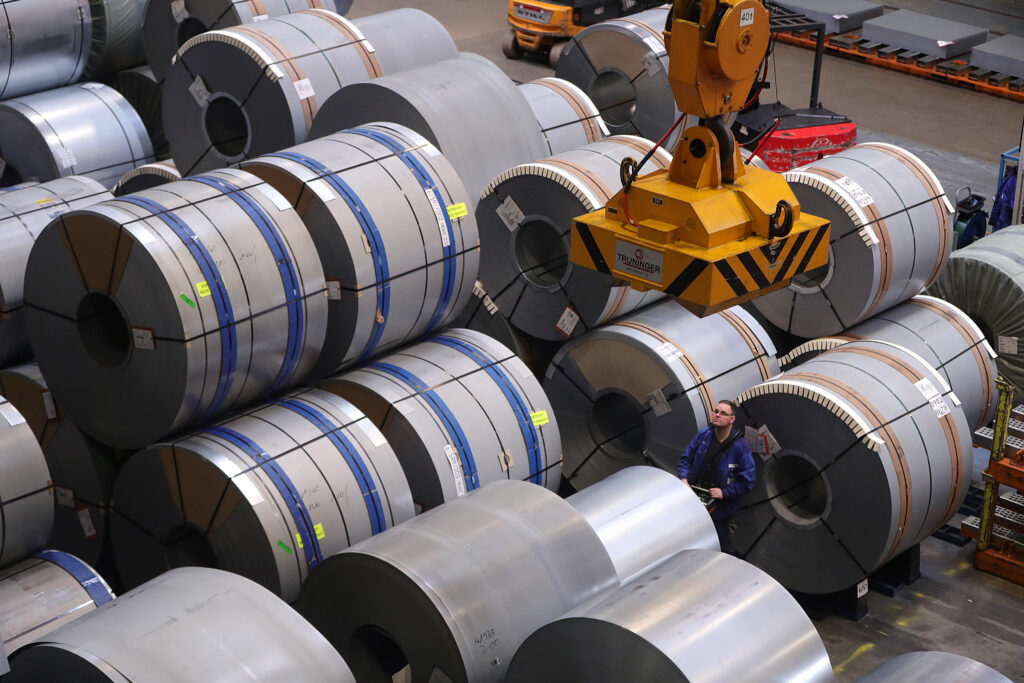
https://iframe.iono.fm/e/1539673?layout=modern” width=”100%” height=”170″ frameborder=”0
You can also access this podcast on iono.fm here.
ADVERTISEMENT
CONTINUE READING BELOW
JIMMY MOYAHA: The steel industry has remained a central topic of discussion for some time now. We’ve scrutinized its effects on our economy and job opportunities. Recently, the Minister of the Department of Trade, Industry and Competition, Parks Tau, suggested that the tariff framework governing the steel sector needs to be reviewed and potentially revised.
This task has been entrusted to the International Trade and Administration Commission, known as Itac. We’ve previously discussed Itac’s involvement with import tariffs.
I’m joined on the line by Itac Commissioner Ayabonga Cawe to discuss the current landscape of the steel sector and what it means for the future. Commissioner, good evening.
Let’s start with the latest announcement from the Department of Trade, Industry and Competition concerning the tariff review. This important task has been assigned to your body, marking a rare occasion since such a review hasn’t been conducted in nearly twenty years.
While I don’t have exact figures, it appears we are reviewing over 600 codes. Can you explain the mandate you’ve been given?
AYABONGA CAWE: Thank you, Jimmy, and good evening to you as well. It’s always a pleasure to connect, and good evening to your audience. You are right in saying that we haven’t reviewed the tariff structure across various chapters, particularly Chapters 72, 73, 82, and 83 related to steel products, for many years.
As you mentioned earlier, this stems from a directive from the Ministry of Trade, Industry and Competition, received shortly before last year’s general elections and now endorsed by the current minister.
The steel crisis is not solely a domestic concern; it reflects a global overcapacity issue. Simply put, our ability to produce steel far exceeds the global economy’s consumption capacity.
This reality compels major producing countries to explore every potential avenue for exporting their surplus.
As a result, over the past few decades, we have implemented a range of safeguard and anti-dumping measures as both South Africa and other nations try to tackle the challenges posed by this global overcapacity and its effects on our local industry.
In line with the directive, we have spent several months engaging with stakeholders in the industry to assess the current tariff framework, including our bound rates under the World Trade Organization.
These discussions have led to the formulation of proposals that may enable us to advise the Minister of Trade, Industry, and Competition on necessary adjustments to the tariff structure.
Additionally, we are also looking into ways to better monitor imports for compliance with trade regulations along with environmental and safety considerations.
Many low-income communities, for instance, utilize galvanized or coated steel products for building informal housing and modular structures. We’ve noticed an increase in imports of these products.
Inconsistencies in specifications and standards can threaten health and safety. One of the proposals we are contemplating is to recommend to the minister that certain products—including steel tanks and tubing—come under import controls, while also assessing the need to adjust tariffs accordingly. We realize that specific steel products are critical input materials for local re-rollers, who transform them into various downstream products that see widespread usage.
JIMMY MOYAHA: Commissioner, let’s touch upon developments within the local industry. Despite government interventions, the steel sector has consistently seen job losses since 2009. Representatives from the industry argue that governmental policies are insufficient to support their conditions.
Will you consider this issue in your recommendations and perhaps suggest that relaxing some policies could bolster local steel manufacturers who are struggling?
AYABONGA CAWE: Which specific policy are you referring to, Jimmy? It’s crucial to clarify that the spectrum of policy areas influencing the steel sector is vast, and discussions often lack specifics on which policies are impacting the industry.
JIMMY MOYAHA: Precisely.
AYABONGA CAWE: It could span a variety of aspects.
JIMMY MOYAHA: Certainly, and from the perspective of the Steel and Engineering Industries Federation of Southern Africa [Seifsa], they are well-equipped to provide valuable insights into their experiences. Conversations with Seifsa and others in the steel sector highlight a tough climate.
Taking into account that the South African government emphasizes infrastructure as vital for development and economic progress—ministers have even suggested transforming South Africa into a construction hub—it does seem contradictory that this ambition is not fully realized.
AYABONGA CAWE: I appreciate your viewpoint. Yes, you are right that numerous issues affecting supply reside within the state’s domain. The government regulates costs associated with rail, ports, electricity, water, and property rates.
However, regarding demand, which is likely the focus of your concern, we have not seen a notable recovery in public-sector or private-sector fixed investment since the global financial crisis.
This stagnation means we are not witnessing the level of construction activity that would typically require substantial steel for building and production.
If some of this stagnation stems from policy uncertainty or a lack of coordination, that is indeed a valid observation.
How well can this review address supply-side challenges? While we cannot directly influence demand, we are soliciting public input on supply-side measures that could enhance the competitiveness of domestic steel producers.
This includes evaluating whether necessary measures exist to support raw material input prices for scrap, iron ore, coking coal, or other materials needed throughout the production process.
Furthermore, we must consider the implications of our bound rates within the WTO, as they constrain how much we can raise tariffs. This is a significant policy issue, because we want to ensure that any domestic demand we generate does not shift towards imports while we have local production capabilities.
To what extent does our existing tariff framework limit our ability to provide effective protection for the industry? That’s an essential angle the review will investigate.
Another element to examine is product diversity. Many mills have limited manufacturing capabilities, and numerous industry players have reached out to us seeking permission to import necessary steel products that local producers do not make.
ADVERTISEMENT:
CONTINUE READING BELOW
We currently have various provisions listed in Schedules 3 and 4 of the rebate provisions of the Customs and Excise Act.
This brings up the question of whether these provisions are being misused and if they should be maintained or modified to manage potential unintended consequences effectively.
These factors will be critical in addressing supply challenges while also tackling demand issues to some extent. However, resolving major demand concerns, especially related to state-owned and municipal investments, might exceed the review’s remit.
Instruments such as designation, in accordance with Section 20 of the Procurement Act, might yield better outcomes in stimulating local investment.
JIMMY MOYAHA: Commissioner, in conclusion, do you think these measures should have been rolled out sooner? Take, for example, the extended pleas by ArcelorMittal [Amsa] for aid regarding policy and market access.
The drop in ArcelorMittal’s stock, which plunged from R265/share during 2008 peak levels to R1.30/share today, underscores significant struggles within the industry.
Should we wait for crises like this—which apply not only to Amsa but the entire industry—before taking action? Should more proactive measures be introduced to prevent such scenarios?
AYABONGA CAWE: Jimmy, I would caution against linking the timeline of this review to the crises surrounding Amsa.
The crisis at Amsa is indeed a part of the overall steel crisis affecting South Africa. We face substantial overcapacity at a national level.
When you combine the capacities of primary steel producers, it becomes clear that local demand does not align with the current production capacity.
The situation at Amsa is significant, but it should not be viewed as the sole trigger for government action.
Our objective must involve positioning the steel sector within a broader national framework, and we hope this review will serve as a guide in that journey, akin to the approaches taken by other countries.
Countries like India provide a strong example in this respect. They began articulating their steel production goals in 2008, planning considerable infrastructure investments by 2030, and aligning these goals with export strategies.
This is the direction we should pursue. While a crisis can instill urgency in dealing with these matters, it is also essential to maintain a historical context when analyzing stock performance.
For instance, comparing the current state of Amsa, which lacks integrated mining access to iron ore, to its historical performance neglects the shifts in demand dynamics since the 2010 World Cup. We must navigate these complexities alongside global market conditions.
Today’s consumption of domestically produced steel relative to imports cannot be evaluated based on the conditions of the early 2000s, especially after China joined the WTO.
The present overcapacity is predominantly driven by surges in production from China and India, creating an imbalance that must be addressed. It’s vital that we identify our unique challenges and learn to navigate crises effectively.
This review of steel tariffs follows long-standing calls for action prior to the Amsa crisis. Indeed, implementing specific import control measures for certain downstream products should have been prioritized right after 1994.
The last import control measures for steel products date back to early 1993, indicating a history of regulatory efforts.
In hindsight, it seems we may have been overly optimistic about the consequences of unrestricted trade in products like steel. While regulations are in place, not every country adheres strictly to them, resulting in sporadic overcapacity crises. We find ourselves with the challenge of crafting a robust response to these hurdles and fostering a thriving steel market rather than merely attributing setbacks to a single firm.
JIMMY MOYAHA: It seems we need to also focus on demand. There are substantial infrastructure projects waiting for development, which could ideally serve as a productive outlet for our excess supply.
However, we will save that discussion for another time. We’ll conclude on that note. Thank you for sharing your insights and thoughts. This has been Itac Commissioner Ayabonga Cawe discussing the steel industry and the ongoing review of the steel tariff structure mandated by the Ministry of Trade, Industry, and Competition.
Stay informed with Moneyweb’s comprehensive finance and business news on WhatsApp here.






